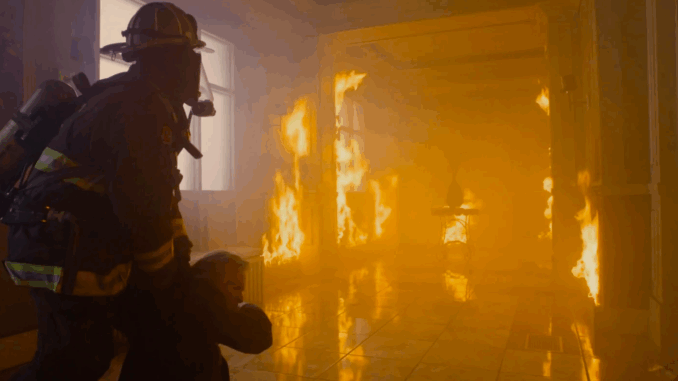
The blazing infernos. The collapsing floors. The narrow escapes from burning buildings. Week after week, Chicago Fire delivers edge-of-your-seat action that feels dangerously real. But behind the high-stakes drama lies a team of stunt professionals, coordinators, and cast members working meticulously to bring every explosive moment to life — safely.
So how does Chicago Fire manage to pull off some of the most dangerous stunts on television without putting its cast in real peril? The answer lies in a finely tuned system of collaboration, precision, and controlled chaos.
Fire Without Fear: Creating Controlled Infernos
One of the most iconic elements of Chicago Fire is, of course, the fire. Real flames are used in many scenes, but they’re not the uncontrolled disasters they appear to be on screen.
“We work with a fire safety team that makes sure everything is tightly choreographed,” explains stunt coordinator Rick LeFevour. “We use flame bars, gelled props, and non-toxic smoke to simulate real emergencies, but in a controlled environment.”
Each fire scene is prepped for hours — sometimes even days — with multiple rehearsals. The actors are trained to understand the physics of fire: how smoke behaves, how heat rises, how fast a fire can spread. Even seasoned performers like Taylor Kinney (Severide) and David Eigenberg (Herrmann) have to rehearse their movements down to the inch.
The Actors Do More Than You Think
Unlike many action-heavy shows, Chicago Fire leans on its cast to perform much of the physical work themselves. Kara Killmer (who played Brett), Miranda Rae Mayo (Stella), and Alberto Rosende (Gallo) have all taken part in extensive stunt training to prepare for the show’s intense rescue scenes.
“It’s not just about running into burning buildings,” says Miranda Rae Mayo. “We learn how to fall correctly, carry weight safely, and navigate tight spaces with gear on. It’s a physical and mental challenge every time.”
While trained stunt doubles are always ready to step in for dangerous maneuvers — like jumping out of windows or rappelling down buildings — many shots you see are the real actors, fully geared up and performing on set.
Timing Is Everything

Each high-stakes stunt is broken down into a series of precise beats. From a floor collapse to a propane tank explosion, the special effects team times every moment to within fractions of a second.
One famous scene involved Severide jumping across a collapsing walkway in a warehouse explosion. While it looked like a spontaneous decision in the episode, in reality, it was rehearsed more than a dozen times with floor rigging, timing lights, and an entire support team watching from just off-camera.
“Taylor [Kinney] has a really good sense of spatial awareness,” notes LeFevour. “That allows us to trust him with things most actors wouldn’t be allowed to do.”
Training With Real Firefighters
The actors are not only working with Hollywood stunt teams — they’re trained by actual firefighters. The Chicago Fire Department often consults on episodes and helps choreograph scenes to make them as realistic as possible.
Many members of the technical team have firsthand experience fighting fires in the city, which lends authenticity and realism to even the smallest moments.
“Chicago Fire is unique because we’re not making it up — we’re recreating real-world rescues,” says technical advisor Steve Chikerotis, a retired Chicago Fire Department battalion chief.
Safety Is Never Compromised
Despite the high drama on screen, safety is paramount on set. Every fire, fall, and explosion is rehearsed multiple times. Stunt coordinators use foam padding, hidden harnesses, breakaway props, and extensive protective gear to minimize risk.
“If we can’t do it safely, we don’t do it,” LeFevour emphasizes.
In a season 11 episode, an actor had to be “trapped” under a collapsed beam. The beam was made of lightweight foam, the fire was a mixture of LED lights and light smoke, and the heat was controlled to avoid burns or respiratory issues.
“It’s a delicate dance,” LeFevour says. “Our job is to make you feel like you’re watching real life — but without ever putting real lives in danger.”
The Magic of Post-Production
While much of the action is captured on set, Chicago Fire relies on post-production magic to heighten the danger. CGI is used sparingly but effectively — especially when it comes to things like adding more smoke, intensifying explosions, or digitally erasing safety cables.
Sound design plays a huge role, too. The crackling of flames, the whine of engines, and the muffled voices through SCBA masks help immerse viewers in the scene.
“Most people don’t realize how much of the danger is in what they hear, not just what they see,” says supervising sound editor Jonathan Fishman.
Why It All Matters
At its heart, Chicago Fire is a tribute to real-life heroes. The show’s commitment to authenticity — and to the craft of stunt work — isn’t just for thrills. It’s to honor the bravery, precision, and courage of first responders who face these dangers every day.
The next time you see Severide crawling through a wall of smoke, or Stella dragging a victim out of a collapsing building, remember: behind every shot is a symphony of experts making the impossible look effortless.
And that’s the true fire behind Chicago Fire.
